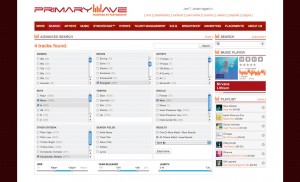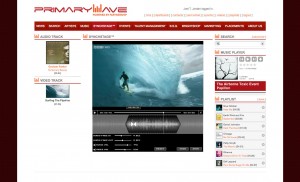SynchTank: Streamlining Music Supervision
DITMAS PARK, BROOKLYN: They’re not cavemen by any means, but when you get down to it music supervisors have ridiculously simple needs: These people need the best possible music that they can afford for their project – FAST.
But that deceptively uncomplicated aim can prove logistically taxing. Content, publishing info, song data, video assets, paperwork, and the other things that make a license tick can be spread haphazardly across the globe, challenging even the best-connected rights holder or music supervisor to pull it all together in time for deadline. Sooooo, in the age of the Internet, which has brought us such workflow miracles as Zipcar, why has no one yet made an efficient system that pulls it all together?
Someone has. Operating out of Brooklyn, SynchTank is a solution that makes sense out of music supervision. A thoroughly comprehensive online subscription-based IP management and licensing system, it’s the brainchild of Joel T. Jordan, who realized that a better synch mousetrap was possible while busily running Earthprogram Music, his own music publishing company and a couple small labels over the past two decades.
Putting his shoulder to the wheel, he and business partner Dave Comeau brought SynchTank to life. The result is a truly all-under-one-roof music supervision resource that record labels, publishers, libraries, ad agencies, media producers – anyone who has to think about synch – needs to know about. In this interview, Jordan was only too happy to help spell it out.
When you meet someone for the first time, how do you describe what SynchTank does?
SynchTank is a new online music technology through which anyone with a catalog of music can set up and power their own uniquely designed cloud-based asset management and licensing system.
SynchTank allows them — or any other user with proper clearance — to access their assets online and perform all the tasks that would normally happen in a day of licensing, from search to pitch, to video compositing, license and delivery. By connecting fragmented offline and online processes with assets and data in one online environment, SynchTank increases levels of efficiency and enables marketing and delivery from virtually anywhere.
That’s definitely something the synch sector can use. Can you drill down deeper into the main functions?
The basic explanation in five steps is that with SynchTank a user can:
1. Search for music by its audible descriptive characteristics — tempo/bpm, key, mood, timbre, vocal pitch, presence, rhythm complexity and more — as well as any combination of writer and publisher information, master or release info, and lyrical content. We use a sophisticated music analysis algorithm to automatically tag the songs with the relevant audible metadata on upload, making it a breeze to set up a deeply enabled search across thousands of tracks.
2. Save selected music into project or client specific playlists with custom artwork and track notes. Users can access, modify, and pitch any of their playlists at any time.
3. Create online video synchronizations of selected tracks with any uploaded video. Users can offset a waveform of the track against the picture to determine the potential of a track and video together without ever leaving the browser.
4. Share, pitch, deliver and track playlists, individual songs, saved searches, and video synchs to contact groups or individuals. Virtually anything on the site can be pitched, and can be sent as a simple email or as fully-branded HTML campaign. Email metrics with detailed information measures the success of each delivery. Recipients can stream the tracks from the pitch page or download the tracks depending on the access level and resolution set for that delivery.
5. License and download any selected song through an automated process. Publishers can accept detailed online licensing requests, while master and copyright owners can create pre-defined licenses and prices to offer automated transactions. That effectively lowers the cost of sale for previously uneconomic transactions.
Very thorough. Why did you develop SynchTank? What was the big problem in music supervision/synch that you wanted to attack, and how does this provide the solution?
I’ve had the fun and sometimes perplexing experience of running an indie label and publishing company for the past 20 or so years, so I’m always thinking as a record promoter and for better ways to promote my tracks and artists, especially for licensing opportunities. I was using all the current methods of the past 5 years – iTunes, Zip, FTP, file-sharing sites, and mailing list programs, but at every step there was some disconnect with applications living offline and online, in different locations, and requiring uploading and downloading and many steps by both parties before the tunes are even heard. To top it off, to be truly mobile meant I would have to carry my catalog — and computer — around with me wherever I would go.

Music supervisors can go into much deeper detail with SynchTank's advanced searches. (click for enlarged view)
Enabling my clients and partners to check out my catalog passively beyond sending out discs, hard drives or massive archive files, and then educating them on what was important and why was another story altogether. Even I didn’t know the entire picture of each tune I owned and wanted to be able to see everything about the track all in one centralized location – master info, writer and publishing info, and audible descriptive data.
I figured there must be a better way than spending afternoons at my desk sourcing tracks with only iTunes, gathering tracks, stuffing them into an archive, uploading them somewhere, sending out the link somewhere, and hoping that the recipient downloaded the tracks, unzipped them and put them in their computer or MP3 player. This is a lot to hope for from a relatively unknown young indie label. Even worse was I wasn’t sending them anywhere that reinforced my brand, my music and my message.
Efficiency didn’t exist as I could only tackle one thing at a time with my limited resources, so any opportunity I could address would mean that another would fall to the wayside. I was watching gigs pass by and taking gambles on others that might not even pan out. I knew all the steps could all be brought into one environment, allowing me to do all the creative work I was currently doing, but without ever having to leave the browser, work on a specific machine, or be in a specific location.
I imagined it wasn’t just me having these problems of access and delivering the materials in a consistent brand-reinforcing manner, and being able to do it from anywhere in an efficient, great-looking way that leads back to an actual measurable result: a view, click, stream, download, feedback or a license.
So I set out to design a tool that would not only reduce frictions and increase efficiency for me, but would also get the recipient to listen to the tunes with the least amount of steps.
So who stands to benefit most from SynchTank? Who are the different user groups that you’re anticipating?
Anyone interested in accessing and promoting their repertoire without the restrictions of traditional storage and delivery methods. By traditional I mean what’s been available for the past five years alone. Our current users are composers, producers, recording artists, bands, publishers, labels, distributors, management companies, production music catalogs, recording studios and synch houses.
I think anyone with creative intellectual property can and should use this software to their advantage. I figure if you’re going to spend money on a website it might as well be extremely useful and not only generate more business, but help you manage it as well.
Who are some adopters right now?
Since January we’ve launched unique systems with top tier US clients like Primary Wave, IRIS Distribution, Reservoir Media Management, and with international clients ATC Mgmt (UK), CueSongs (UK), and Budde Music (Germany). We’re now in negotiations with one of the majors, as well as many more indie labels, boutique publishers, digital distributors, and sound designers.
This is a deep system. How would you describe the experience of bringing something like this from concept to reality?
It started off like Superman III: sketched out on a napkin one night in the summer of 2008! Since then it’s been an exhausting and exhilarating process making it come to life.
It’s been one of the longest projects I’ve personally ever been involved with, but one of the most deeply satisfying experiences as well because we’ve actually solved a real industry- wide problem. It’s been so much work — thought, design, discussing, sketching, programming, rethinking, redesigning, reprogramming — over and over till it’s refined.
The core design and development was done by just two people — myself and my partner Dave Comeau — and not by committee, so we’ve been able to move very quickly. We’re both relatively talented at what we do — me being the designer, and him being the know-it-all programmer that literally can do it all — so we were able to sketch out the idea and have a working model that actually looked really good in about five months.
After the first beta we spent a year adding on and improving, breaking it up into a series of small projects that would compose the whole system, allowing us to focus without running in 20 directions. This August will be the start of the fourth year of development and halfway through our first year as a revenue-generating business. There’s really no end in sight to our R&D plans, as the customers are now coming up with great suggestions to make the gear better and better, and we’re at it daily.
It’s great working with the labels and publishers: As they’re getting the benefit of real time development, without any of the risk or expenses of trying to develop and manage long-term high-tech projects internally, we’re benefiting from some of the most creative minds in music, marketing, and licensing helping to shape the product.
It’s a win-win! What have been the other big happy surprises that come with starting a niche-oriented, music industry business like SynchTank. What’s making all that work rewarding and worth the effort?
The biggest surprise was that there was an opportunity to begin with. When I was initially doing research on existing systems I knew there were systems that did a bit of what I wanted, but upon a deeper look there was nothing out there that was affordable, did all the tasks I had hoped for in one place, and could be designed and modified any which way and without a ton of up front costs.
Now that the gear exists, I can see that I’m not the only one that feels this way, and that’s been the second biggest surprise: How quickly it’s being embraced by many different types of companies at many different levels. It’s really rewarding to be assisting so many different cool companies with unbelieveable catalogs. We’re helping the industry solve some of its long-standing access and asset management problems, and at the same time helping the industry grow.
On top of what SynchTank is contributing, how do you see the music supervision/synch sector evolving, and why are new solutions for this market still needed – by both music buyers and sellers?
By easing processes and integrating the management, discovery, licensing and promotion of music into one platform, we’re now able to address more business and with higher levels of efficiencies across individuals or organizations. Through even more automation and computer aid we can shift the gears of the global music licensing economy and enable an even larger, yet-to-be seen music market to emerge.
That’s what we call the big picture! So who inspires you? Let us in on some other business/music innovators who are keeping you motivated.
Steve Wozniak, Jim Henson, and Mark Twain. These days I find just the sheer number of new inventors and operations that have sprung up to support their ideas inspiring. The amount of ingenuity that is happening right now is mind-blowing. At times it’s like watching digital evolution at fast forward, and every day there is a guarantee of something new to learn. We’re very excited to be a part of this wave of innovation that is shaping new methods and technology. Thankfully there will always be a problem to solve, and that’s motivation enough.
Amen! What makes NYC the right place to launch SynchTank from?
I’ve been in NYC for 15 years now and I don’t know anywhere else I could get the inspiration, the guidance or the energy from. If I weren’t in the center of it all, the project probably wouldn’t have clicked as quickly as it did. I can’t imagine being anywhere else trying to do something as in-depth without the given wealth this city offers.
Being here I have been able to seek out advice and expertise on anything and everything music-, copyright-, licensing-, business-, legal- and tech-related from some of the most connected and knowledgeable individuals that call NYC home. I have been able to literally take it to the doorsteps of the intended users and gather real time feedback as it develops.
— David Weiss
Please note: When you buy products through links on this page, we may earn an affiliate commission.









